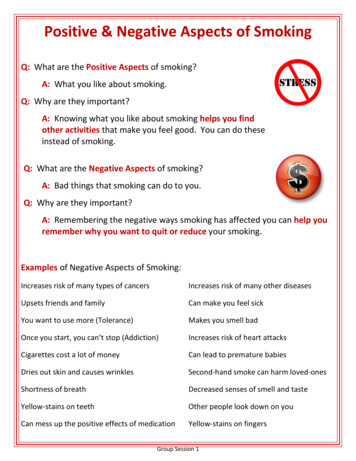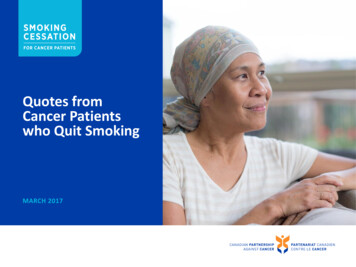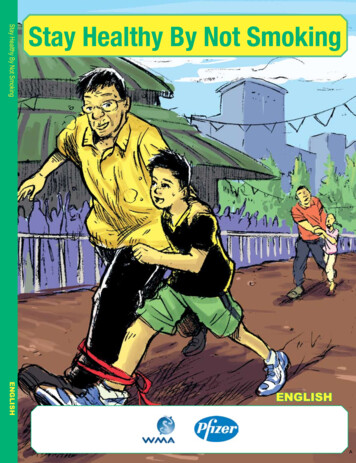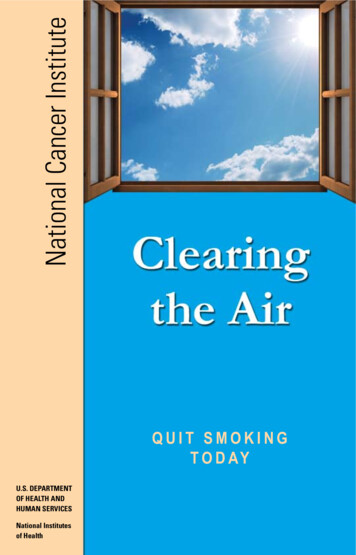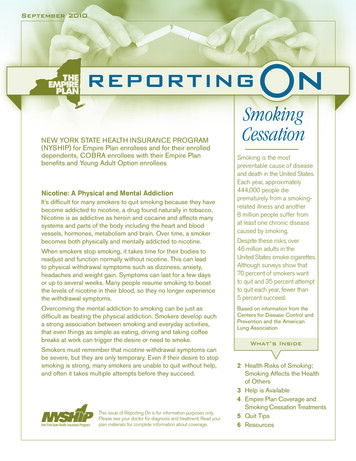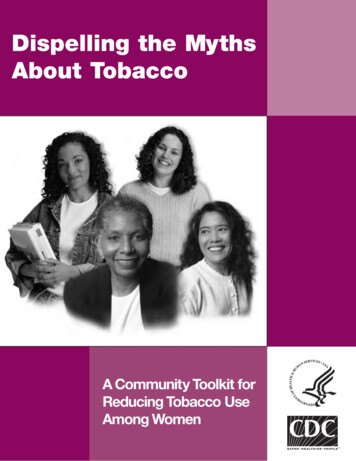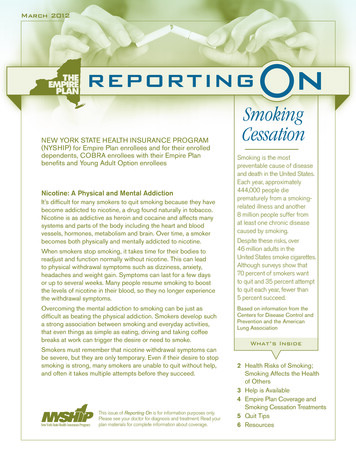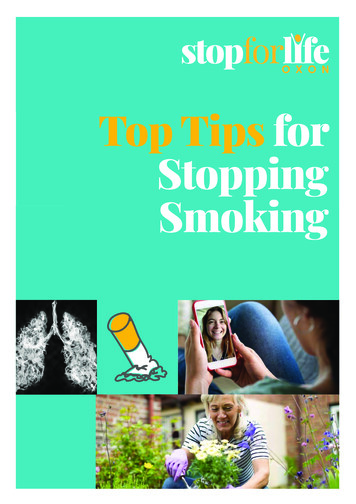
Transcription
Plan to Stay in Shape TodayQUIT SMOKINGAND SEE THE BENEFITSON YOUR HE A LT H
QUIT SMOKINGAND SEE THE BENEFITSON YOUR HE A LT HYOU MAY REMEMBER THE DAYS WHEN SMOKING WASPERMITTED ON AIRPLANES AND EVEN IN OPERATINGROOMS. OUR IGNORANCE OF THE DEVASTATING EFFECTS OFCIGARETTES AND SECOND-HAND SMOKE WAS DREADFUL.In recent decades, the fight against smoking has spreadto all levels of society and become a public health priority.Government bodies and organizations have taken stepsto regulate tobacco marketing and sales and smoke-freeareas and set up support programs for people who wantto quit. The vast majority of smokers today know thatsmoking is harmful, but it can be really hard to stop.If you’re a smoker and you’ve picked up this guide, you’vetaken a big step in the right direction! This guide describeswhat’s involved in quitting, the reasons it’s so hard, theobstacles you’ll face and tips for reaching your ultimategoal: becoming a non-smoker!
TABLE OF CONTENTSHISTORY4STARTLING NUMBERS5WHAT’S IN A CIGARETTE?7WHAT CAUSES ADDICTION?8THE LOWDOWN ON SMOKE10SMOKING’S EFFECTS ON THE BODY12SMOKING CESSATION13QUITTING STRATEGIES19Nicotine replacement therapy20Nicotine-free products28ELECTRONIC CIGARETTES29TIPS AND TRICKS31NEED HELP?32
QUIT SMOKING AND SEE THEBENEF ITS ON YOUR HE A LT HHISTORYTobacco has been consumed in the Americas for hundreds of years.Indigenous peoples first used tobacco in rituals to communicate withspirits and relieve pain. After his journey to the Americas in 1492,Christopher Columbus introduced tobacco to Europe. Since then,tobacco use has spread around the world.Cigarettes were first invented sometime in the 1830s. In the 20thcentury, big companies started multiplying and manufacturingcigarettes in industrial quantities. During the First and Second WorldWars, manufacturers provided soldiers with free cigarettes as a meansof mental escape.With time, cigarettes became part of the lifestyle, a tool used to seduceor impress or integrate social groups, and a symbol of the transitionto adulthood and independence. From the ’50s to the ’70s, marketingcampaigns focused on the symbolism and imagery associated withsmoking. They featured film stars, fictional characters, and famousfigures like Marilyn Monroe, Lucky Luke, and John F. Kennedy,smiling with a cigarette in hand or between their lips. Some cigarettemanufacturers even capitalized on public trust in doctors, recruitingthem to vaunt the smoothness and flavour of a cigarette after a hardday’s work.Then we realized the effects of smoking. Unfortunately cigarettecompanies are still making a fortune at the expense of consumers andtheir health. Despite numerous lawsuits and billions of dollars paid indamages and interest, they continue to attract millions of consumers.4
Today, the evidence is undeniable, and smokingis no longer cool or sexy. The fight againstsmoking has even become a public healthpriority.STARTLINGNUMBERSEvery yearon May 31,the World HealthOrganization celebratesWorld No Tobacco Day.Here in Quebec,the third week ofJanuary is QuebecTobacco-freeWeek.An estimated 20% of Canadians still smoke regularlyor occasionally. We’ve made great strides in recentyears, thanks to the development of smoking-cessationmedication, anti-smoking campaigns, increased taxes on tobaccoproducts, and smoking bans in bars, restaurants, and many publicplaces. Nevertheless there are still far too many smokers.WANT TO SEE THE NUMBERS? There are about one billion smokers on the planet, and 80%of them live in low- and middle-income countries. It is estimated that onesmoking-related illness.in two smokers will die from a Each day, 15 billion cigarettesare sold around the world.5
QUIT SMOKING AND SEE THEBENEF ITS ON YOUR HE A LT H Each day, 10 billion cigarettes are thrown away outdoors—areal threat to the environment.DID YOU KNOW that cigarette filters take more than10 years to break down? Think about that before youthrow your butt out the window! Smoking increases the risk of strokethree times for men 82% of smokers startsix times for women andbefore age 18. Each year nearly 40,000 deaths are associated with smoking,making it the primary cause of avoidable death in Canada. That’s onesmoking-related death every 14 minutes. On average, smokers’ lives are 10non-smokers’.years shorter thanTHAT’S A LOT OF NUMBERS!HERE ARE SOME MORE.In concrete terms, smoking is responsiblefor: 85% of lung cancer cases 85% of COPD (chronic obstructivepulmonary disease) cases 30% of all cancers 30% of cardiovascular diseases6Everycigarette youdon’t smokeadds around10 minutes toyour life.Smoking is also responsible for: Increased healthcare costs The introduction and enforcement of laws and regulations Lost productivity at work and at home Premature deaths Incapacity And so much more
WHAT’S INA CIGARETTE?Tobacco products come in different forms. There are cigarettes, cigars,cigarillos (miniature cigars), smokeless tobacco (chewing), pipes, andwater pipes (shisha or hookah). In theory, electronic or e-cigarettes soldin Canada don’t contain nicotine. At the time of writing, e-cigarettescontaining nicotine are illegal, and thus unregulated, in Canada (seepage 29).Nicotine, a naturally occurring substance in tobacco, is the cause oftobacco addiction.Nicotine is not carcinogenic in and of itself, but the toxic vapours andproducts generated by burning tobacco are a different story. Of thethousands of chemicals generated by tobacco, about 50 are thoughtto be carcinogenic. The smoke generated by this chemical reactioncontains:Chemicals generated from tobacco OXIDEACETICACID7
QUIT SMOKING AND SEE THEBENEF ITS ON YOUR HE A LT HWHAT CAUSESADDICTION?Our body works through reward systems to satisfy needs like hunger,thirst, and sexual desire.Our brains release endorphins naturally, for example, when we workout. This creates a feeling of well-being and relaxation after an effort.Our bodies secrete these substances independently when we fulfilla need. But when an endorphin release is triggered by an externalsubstance (in this case, nicotine), the brain gradually gets lazy andeventually needs more of this external source to make up for its lack ofendorphins.When nicotine is inhaled, it takes just 10 seconds for it to penetrate thelungs, enter the bloodstream, and make its way to the brain, where itcan do its damage.Once in the brain, nicotine triggers the release of dopamine, a chemicalsubstance associated with pleasure. The dopamine release creates afeeling of well-being and relaxation, reduces irritability and hunger,enhances concentration, and makes people feel alive. So it’s easy tosee why smokers repeat the experience.8
SmokinggsLunPleasurealrawdithWinem sepaleaCirs cuyst lateyormBrainDoreAfter just two to four hours without nicotine, thebody may start to feel symptoms like a headache,mild depression, anger, anxiety, and sleepissues. It’s withdrawal.What’s more, the craving for a cigarettegoes beyond the physical addiction tonicotine. On the emotional level, smokinghelps to manage stress, anxiety, anger, pain,and even joy. But hold on! That doesn’t makesmoking the solution to our problems.Nicotine is easilyaccessible and absorbedso quickly by the brain’sreceptors that it’s thesubstance we become mostaddicted to, more so thaneven cocaine, alcoholor heroin.9
QUIT SMOKING AND SEE THEBENEF ITS ON YOUR HE A LT HTHE LOWDOWN ON SMOKEThere are three types of smoke created by tobacco consumption:First-hand smoke is directly inhaled by the smoker. It’s quickly trappedin the lungs and the rest of the body.Second-hand smoke refers both to smoke from the tip of the cigaretteand smoke exhaled by the smoker. It probably gets the most “publicity,”because it’s harmful, smells bad, and is even more carcinogenic thanfirst-hand smoke. People around smokers can’t control this smokebecause they inhale it involuntarily.Second-hand smoke: Increases the risks of cardiorespiratory disease Increases the risk of cancer Reduces fecundity and fertility Hampers fetal development in pregnant women Causes respiratory difficulties, migraines,eye and throat irritation Is considered an asthma trigger10
Third-hand smoke is what remains trapped in objects like stuffed toys,couches, walls, floors, cushions, carpets, vehicle seats, and so on. Evenafter the odour is gone, third-hand smoke can remain in inanimateobjects for years.CAREFUL!Exposure to second- and third-hand smokeis more harmful for children than for adults.Their bodies are growing and haven’t matured.Plus they naturally breathe faster and havea tendency to put objects that are potentiallycontaminated by smoke in their mouths. Thisincreases the risk of ear infections, psoriasis,asthma, allergies, learning and behaviouraldifficulties, and other issues.We have a duty to protect our children.They can’t leave smoke-filled spaces wheneverthey like. A smoke-free home is a lifelong giftto your children.11
QUIT SMOKING AND SEE THEBENEF ITS ON YOUR HE A LT HSMOKING’S EFFECTSON THE BODYIn addition to creating a vicious cycle of physical and psychologicaldependency, smoking has substantial effects on the body. Contrary topopular belief, smoking isn’t just harmful for the respiratory system; italso causes:Premature ageing of the skin, theappearance of deep wrinkles, a dullcomplexion, dry skin, reduced healingpotential, increased hair loss, andyellowing of nails, fingers,and teethShortness of breath,increased risk of infectiousinflammatory diseases,asthma, and COPD(bronchitis andemphysema)Reduced libido (bothmen and women),impotence, erectiledysfunction, elevatedrisk of birth defects,reduced fecundity andfertility, and prematuremenopause12Ophthalmic issues, cataracts,altered taste and smell, pooreating habits, dental issues, guminflammation, tooth decay, looseteeth, and bad breathThickened blood leadingto increased stroke risk,increased heart rate,and blood pressure,sleep and other issuesIncreased bonefragility, heartburn,gastroesophagealreflux disease,and constipation
SMOKING CESSATIONQuitting smoking is no easy task, but with the right tools, anything ispossible. Of course, there will be obstacles on the way. You’ll need tobreak the vicious cycle of physical addiction caused by nicotine and thepernicious feeling of well-being it provides, as well as the psychologicaladdiction associated with moments of relaxation and decreased stress.That’s why you should arm yourself with patience, willpower, andmotivation.The very first step is to make a game plan or strategy.It takes preparation to reach that all-important goal ofbecoming a non-smoker!You’ll needto find yourown reasons andmotivations forquitting.1PRE-CONTEMPLATION: At this stage,smokers don’t think quitting is an option.They aren’t receptive to messages aboutthe negative effects of cigarettes. They’redefensive and often disillusioned aboutquitting. And they don’t have any changesplanned in the near future.2CONTEMPLATION: Smokers in the contemplationphase are thinking about quitting in the next six months.They’re increasingly aware of smoking’s harmful health effects.They don’t exactly know how they’ll quit, but the idea is slowlysinking in. Does this describe you?3PREPARATION: This phase marks the transition from thinkingabout quitting to taking action. A quit date is set for less thana month away. In this phase, smokers actively seek informationabout available treatment options and support programs.13
QUIT SMOKING AND SEE THEBENEF ITS ON YOUR HE A LT H4ACTION: Quitting officially begins. The last cigarette is stubbedout. The action phase lasts six months from the last cigarette.This step is particularly difficult, especially during the first month.It takes perseverance!5MAINTENANCE: After six months without smoking, ex-smokersenter what’s known as the maintenance phase. The goal here isto stay smoke-free! That means managing temptation to avoidrelapsing.6RELAPSE: Yes, relapsing is part of the normal quitting process.But it shouldn’t be seen as a failure. Relapses can happen at anytime, but are most common within two weeks of quitting.The first two weeks after the last cigarette are often the most critical.During the first three or four days, smokers are often highly motivated,but reflexes are quick to return, withdrawal symptoms kick in, andmotivation decreases. That’s why it’s important to be persistent.Most smokers average five to seven attempts before they quit for good.So don’t lose hope. You’ll get there!DID YOU KNOW that one in two Canadian smokerswill make at least one attempt to quit every year? About20% of smokers will quit on their first attempt, 50% aftersix, and 100% after 12, which means there’s hope ifyou’re persistent!14
THE HABITS THAT COME WITH SMOKINGOnce you’ve set your quit date and made your game plan, you’ll needto identify your cravings and critical moments. One of the hardest partsof quitting is that smoking isn’t associated just with an emotion or stateof mind, but with specific moments and activities. Smokers will say theysmoke: While having a cup of coffee After working out While drinking alcohol Before bedtime After meals When they are alone In the car At restaurants During breaks at work With friends While watching television And so onThese situations are often the hardest to avoid. They’re such aningrained part of smokers’ daily lives that it often takes extra effort tokick the habit.An impromptu evening out, a drink or two, and whoops—out come thecigarettes.Triggers are different for everyone, so it’s important to recognizeyours and to avoid them as much as possible so that you canlearn to handle them on a daily basis.The “danger” of relapse is higher at certain times or events, includingparties, the holiday season, and periods of intense emotion.For every reason you have to reach for a cigarette—whether it’s torelax, out of habit, or for pleasure—you need to find an effectivecounter-strategy.15
QUIT SMOKING AND SEE THEBENEF ITS ON YOUR HE A LT HTHE BENEFITS OF QUITTINGThe benefits of quitting start within minutes of butting out your lastcigarette. Over time, respiratory and cardiovascular risks decline andyour quality of life and life expectancy improve.Time sincequittingBenefits associatedwith quitting20 minutesYour blood pressure and pulse return to normal.1 dayYour heart attack risk decreases.2 daysYour senses of taste and smell improve.3 daysYour bronchi open more, breathing is easier,and energy increases.3 monthsYour blood flow and lung function improve.9 monthsYour coughing, nasal congestion, and shortnessof breath improve. Your fatigue decreases,and your energy levels gradually improve.1 yearThe risk of heart disease is half that of a smoker.5 yearsYour stroke risk decreases significantly.10 yearsYour risk of lung cancer as well as other relatedcancers (e.g., mouth, throat, esophagus) isdecreased.15 yearsYour heart disease risk is similar to that ofa non-smoker.Source: Government of Canada16
In addition to improving your quality of life and making a healthierenvironment for your family and friends, quitting is also good for: Your wallet Your energy level, shortness of breath, and fitness Your body image and attitude And much moreWARNING!You may be surprised to learn that cigarettes cancause multiple drug interactions. If you use medicationon a regular basis and you decide to stop smoking, tellyour pharmacist so he can monitor you properly(e.g., side effects, dosage adjustments, blood samples).WHY DO PEOPLE GAIN WEIGHTWHEN THEY STOP SMOKING?The weight gain associated with quitting is a big obstacle for manysmokers who want to kick the habit. Fear of weight gain is enoughto dissuade some smokers from even thinking about quitting.Yet the health advantages of quitting largely outweigh the riskof gaining weight!17
QUIT SMOKING AND SEE THEBENEF ITS ON YOUR HE A LT HThere are a number of reasons for potential weight gain.1Smoking speeds up the metabolism and increases energy(calories) consumption, so cigarettes can lead to weight loss.Nicotine can also suppress appetite by raising blood sugar levels.When blood sugar is higher, the body signals that, in theory, it’shad enough to eatWhen a person stops smoking, the absence of nicotine can leadto decreased energy consumption (fewer calories burned) andincreased appetite, which may translate into weight gain.2People appreciate food more because their sense of taste andsmell improves within 48 hours of quitting. As a result, thepleasure derived from eating grows and the desire for foods thatare rich in fat and sugar may increase.3For some, the habit of constantly having a cigarette in their handsor mouth is replaced by eating. Since it’s easy to fall into this trap,one trick is to use aids like a stress ball or chew a cinnamon orcelery stick—in short, to keep your hands and mouth busy.4Others may eat more for the same reasons they used cigarettes(e.g., to manage stress, avoid boredom, pass the time, or rewardthemselves), which can also lead to weight gain. It’s important toavoid these situations as much as possible.The average weight gain is estimated to be around 2 to 4 kg (4 to 8 lb.),which is why most people won’t see significant changes.Remember that simple lifestyle changes like healthy eating and regularexercise help to maintain a healthy weight. And always keep in mindthat the benefits of quitting outweigh the risks of weight gain.18
QUITTING STRATEGIESThere is no miracle recipe for quitting. Some people succeed on theirown without assistance. More power to them! For everyone else, thereare a variety of methods to help kick the habit.Pharmacological aids have been proven to double or even tripleyour chances of quitting and reduce withdrawal symptoms andrelapse risks.There are two types of pharmacological aids: Nicotine replacement therapy, which delivers nicotine by meansother than tobacco Products that do not contain nicotine (prescription medication)Under certain conditions, insurance covers part of the cost forpharmacological aids. Talk to your pharmacist to see if you are eligible.DID YOU KNOW. You might think that quitting iseasier for a light smoker (less than 10 cigarettes a day) than aheavy smoker (more than 20 cigarettes a day). But it’s just ashard because the addiction is often more psychological thanphysical for light smokers.19
QUIT SMOKING AND SEE THEBENEF ITS ON YOUR HE A LT HNICOTINE REPLACEMENT THERAPYThe choice of nicotine replacement therapy (NRT) depends on thesmoker’s needs, previous attempts to quit, level of addiction, andproduct tolerance, among others. You’re considered to be heavilyaddicted to nicotine if you: Smoke your first cigarette within 30 minutes of waking up in themorning Smoke more than 20 cigarettes a dayThe goal of NRT is to provide a dose of nicotine without the tobaccoand its other harmful by-products. The dose may be delivered via a skinpatch, gum, lozenges, sprays or inhalers.THE PATCHTransdermal nicotine patches feature a thin film containing nicotine,which is released in a controlled manner through the skin. Patchesprovide your body with a “continuous,” prolonged dose of nicotine.When to apply the patchPatches remain effective for about 24 hours. As a result, we recommendapplying the patch when you wake up and applying a new one the nextmorning. Some people may not tolerate wearing the patch overnight.Most smokers don’t wake up to smoke so they’re not used to receivingnicotine in their sleep. In some cases, people wearing a patch at nightreport unusual and vivid dreams. They may be advised to remove thepatch before going to bed and put a new one on the next morning.But be careful if you opt for this approach! If you have a tendency tosmoke your first cigarette within minutes of waking up, make sure yourmorning craving is under control, even without the patch at night.20
Where to apply itPatches should be applied to a clean, dry, hairless area that doesn’t getirritated and is visible in the mirror (so you don’t forget it). Preferredareas are the shoulders, outer arm and parts of the abdomen wherethere isn’t too much fat. Avoid sticking the patch to your breasts orover the heart. If the chosen area is hairy, we suggest trimming thehair rather than shaving it before applying the patch. Irritated skin mayaffect nicotine absorption when patches are applied.It’s best to wait one week before reapplying a patch to thesame spot to avoid irritating the skin and affectingabsorption. Vary your application sites.Handy tipsPatches are water resistant, so you can shower or swim while wearingone. If the patch comes loose, try to re-apply it or put on a new one.Intense exercise may increase nicotine absorption. You may be advisedto remove the patch 15 minutes before activity and replace it after.WARNING!Do not smoke when wearing a patch. Andnever cut patches into pieces so as to preventthe reservoir from releasing nicotine tooquickly.21
QUIT SMOKING AND SEE THEBENEF ITS ON YOUR HE A LT HAre there side effects?When you apply a patch, you may feel a slight tingling or itchingsensation. This is normal, and symptoms usually subside within one hourof application. When the patch is removed, the skin may temporarily bered and slightly puffy. This should also return to normal within an hourof removal.If you experience intolerable itching, intense redness, or severe swelling,you may be having trouble tolerating the product. Some people reactmore than others to the glue used to secure the patch in place or tocutaneous nicotine absorption. Before giving up on the patch, talk toyour pharmacist. There are solutions to these issues.Treatment durationNicotine patches come in three different doses. The goal is to graduallydecrease the dose of nicotine in the system to help your body adjustand gradually reduce withdrawal symptoms.The quitting process should usually take about 12 weeks. It is importantto respect the time frame to increase your chances of success. Somepeople try to stop using the replacement therapy quicker, thinkingthey are ready, but studies have shown that the 12-week scheduleis actually the most beneficial and effective. Incontrast, treatment exceeding three monthshas not proven to be any more effective.DID YOU KNOW?A cigarette containsabout 1 mg ofnicotine.22
SHORT-ACTING AIDSThe patch alone may not control all of your cravings for cigarettes,which is why gum, lozenges, sprays, and inhalers exist. These productsalso contain nicotine and are used on a short-term basis to calm strongurges to smoke, usually in combination with patches.GUMNicotine gum contains a precise quantity of nicotine roughly equivalentto the amount in a cigarette. Gum is available in different doses andflavours for everyone’s tastes. Be careful! Nicotine gum is not used inthe same way as ordinary chewing gum. Since nicotine is absorbedthrough the gums and cheeks and not by swallowing, the chewingtechnique is extremely important to make sure the treatment is aseffective as possible.Instructions:1Chew the gum a few times to soften it and releasethe nicotine.2When your tongue feels slightly numb, place the gumbetween your cheek and gum for one to two minutes.3Chew the gum a few times to releasemore nicotine.4Put the gum back between your cheek and gumsfor one or two more minutes.5Repeat this process for 30 minutes and then throwthe gum away.23
QUIT SMOKING AND SEE THEBENEF ITS ON YOUR HE A LT HAre there side effects?You may feel side effects when using gum, especially if you chew toofast and excess nicotine is released. Side effects may include: Headache Hiccups Increased appetite Nausea Light-headedness Altered sense of tasteThese effects are usually temporary, but if they grow intolerable andyou think they’re caused by the gum, talk to your pharmacist.Handy tipsAvoid drinking or eating 15 minutes before using gum and while chewingso as not to affect the product’s effectiveness.The maximum recommended number of pieces of gum is 20 to 30 perday, depending on the dose of nicotine they contain. Anything over andabove this quantity and you probably need to reassess your nicotinepatch dose. Gum can be used on its own for a maximum of threemonths and then occasionally when you have cravings.24
LOZENGESLike gum, lozenges contain a precise quantity of nicotine, equal toabout one cigarette. For best results, place a lozenge between yourcheek and gum and let it dissolve. This usually takes 20 to 30 minutes.You can move the lozenge from one side of your mouth to the other.Don’t crunch or swallow it, and avoid drinking or eating while it is inyour mouth so as not to affect nicotine absorption.Lozenges should be used at intervals of one and a half to eight hours,without exceeding the maximum dose of 15 to 25 lozenges per day,depending on the strength used.DID YOU KNOW. Gum and lozenges comein popular flavours like mint, fruit, and cinnamon.Not only do they taste good, they also leave yourbreath a lot fresher than a cigarette does.MOUTH SPRAYSMouth sprays are used the same way as gum or lozengesto calm powerful cravings for nicotine. Simply spray the productin your mouth when you feel the urge to light up. The advantageof sprays is that they’re small and discreet and act quickly—within a minute.The main side effects reported with sprays are mouth andthroat irritation and hiccups. The maximum recommendeddaily dose is 64 sprays per 24 hours. Mouth spray can beused alone or in combination with nicotine patches.25
QUIT SMOKING AND SEE THEBENEF ITS ON YOUR HE A LT HINHALERSUsing a nicotine inhaler feels a little like smoking because of themouthpiece you inhale from. To use an inhaler, you insert a nicotinecartridge in the reusable mouthpiece.With the inhaler, nicotine is released through inhalation and thenabsorbed through the mucous membrane of your mouth. Since someof the nicotine is also absorbed through the lungs, it’s best to chooseother replacement therapies if you suffer from lung disease or asthma.One inhaler cartridge is good for 20 minutes of inhalations, consecutiveor not. For example, you can use it:2X10 MINUTES4X5 MINUTESand so onHowever, once started, a cartridge is good for 24 hours. A maximum of12 cartridges per day is recommended, depending on your degree ofaddiction and the stage you’ve reached in your quitting process.A pack-a-daysmoker makes about90,000 hand-to-mouthmovements a year—a reflex that reinforcesthe addiction. Using theinhaler on an occasionalbasis helps graduallyreduce this habit.26
Handy tipsAs with gum and lozenges, avoid drinking or eating 15 minutes beforeand while using an inhaler so as not to affect product effectiveness.The recommended duration of treatment is about three months butcan be up to six months.Inhalers can be used alone or with nicotine patches.WHICH OPTION TO CHOOSE?Some smokers decide to stop smoking byusing only short-acting therapies. At the verybeginning, this strategy helps them graduallydecrease the number of cigarettes smokedper day and increase the time betweencigarettes. But the entire quitting processtends to extend over six months ratherthan three. Short-acting options are beingrecommended less and less often for use ontheir own.Research has shown that pairing nicotinepatches with short-acting products producesbetter control and substantial benefits, whichis why combined therapy is often the firsttreatment option.27
QUIT SMOKING AND SEE THEBENEF ITS ON YOUR HE A LT HNICOTINE-FREE PRODUCTSAfter assessing your condition, medical history, and medication, yourdoctor may decide to prescribe you pills. Like nicotine replacementtherapy, this kind of medication is also prescribed for about 12 weeks.Non-nicotine treatments target chemical substances in the brain thatare responsible for addiction. With these treatments, smokers stopsmoking on their own within 7 to 14 days of starting the medication.These drugs are not for everyone. Talk to your doctor to find out if thisoption is right for you.ALTERNATIVE THERAPIESSome people turn to alternative methods such asacupuncture, hypnosis, and laser therapy to quitsmoking; however, none of these methods arerecognized by Health Canada as an effectiveway to stop smoking.28
ELECTRONIC CIGARETTESElectronic cigarettes, more commonly known as e-cigarettes, havemade a real splash since they first arrived on the market. These small,battery-powered handheld devices resemble a small flashlight or largepen. They have a cartridge that is filled with liquid. Users inhale warmflavoured vapours rather than tobacco. E-cigarettes also mimic theaction of bringing a cigarette to your mouth.There are all kinds of flavours available. E-cigarettes are tempting,but the lack of monitoring and regulations surrounding their sale andmanufacturing is a source of concern for many.In Canada, the sale of electronic cigarettes containing nicotine is illegal.Fortunately, e-cigarettes have been subject to the Tobacco ControlAct since 2015. It is illegal to sell electronic cigarettes to minors or touse them in areas where cigarettes are prohibited. As a result, theiradvertising and promotion is restricted, just like for tobacco products.However, the sale, manufacturing, labelling, and promotion are notyet regulated and do not adhere to specific rules. Unfortunately, atthe time of publication, it’s impossible to know exactly what’s in theseproducts or what the long-term consequences of their use are. As aresult, e-cigarette users, dubbed vapers, don’t really know what theyare exposing themselves to.Even though studies have not proven their effectiveness, e-cigarettesare being used successfully by some smokers as cessation aids tohelp them gradually kick the habit. On the other hand, the flavouredvapours used in e-cigarettes also attract other consumers, includingyoung people, who may try them out of curiosity and eventually makethe swit
QUIT SMOKING AND SEE THE BENEFITS ON YOUR HEALTH 6 Each day, 10 billion cigarettes are thrown away outdoors—a real threat to the environment. Smoking increases the risk of stroke six times for women and three times for men 82% of smokers start before age 18. Each year nearly 40,000 deaths are associated with smoking, making it the primary cause of avoidable death in Canada.

